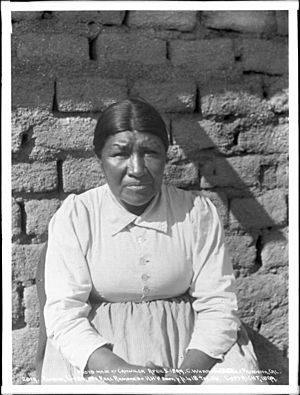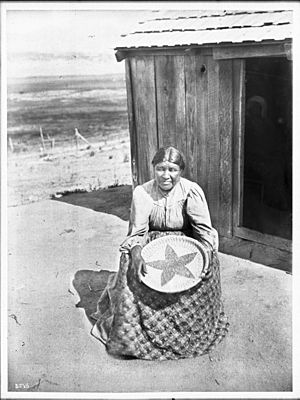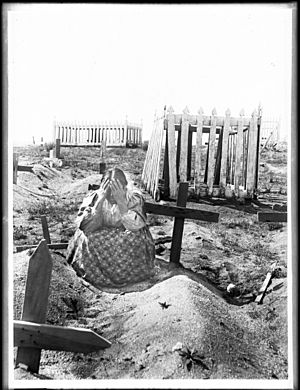Ramona Lubo facts for kids
Quick facts for kids
Ramona Lubo
|
|
|---|---|

Ramona Lubo, 1899
|
|
| Born | 1865 |
| Died | July 20, 1922 (aged 56–57) |
| Resting place | Cahuilla Indian Reservation |
| Nationality | Cahuilla |
| Occupation | basketmaker |
| Children | 3 |
Ramona Lubo (born 1865, died 1922) was a talented Cahuilla basket maker. She became famous because people connected her to the popular novel Ramona by Helen Hunt Jackson. Many called her the "real Ramona."
Contents
Ramona Lubo's Early Life
Ramona Lubo married a Cahuilla man named Juan Diego. He worked with sheep. They lived in an area of California now called Juan Diego Flats. Sadly, their first two children died when they were very young.
Juan Diego sometimes behaved in unusual ways. In March 1883, he took a horse belonging to a man named Sam Temple. Juan Diego wanted to ride home. Temple followed him and shot him. Ramona Lubo saw everything happen.
Temple told a local judge that he shot Juan Diego in self-defense. He claimed Juan Diego had a knife. Ramona said her husband did not have a knife. However, she was not allowed to speak in court because she was Native American. At that time, a California law stopped Native Americans from testifying in cases involving white people. This law was not changed until 1955. Temple was found not guilty, as the court decided he was defending himself.
Life on the Reservation
After Juan Diego's death, Ramona Lubo moved to the Cahuilla Indian Reservation near Anza. Later, she had another son named Condino.
Ramona was a skilled basket maker. She made baskets for carrying water and for processing grain. For the Cahuilla people and other tribes in California, baskets were very important. They were used for preparing and storing food. Baskets were also given as gifts to strengthen family ties.
Baskets were also a form of art and self-expression. Each basket weaver had their own unique style. The baskets often had special meanings, showing the Native people's connection to the land. A writer named George Wharton James even showed one of Ramona's baskets at a lecture in 1903.
Ramona earned money by selling her beautiful baskets. She also washed clothes and picked apricots.
The Novel Ramona
The novel Ramona (published in 1884) was written by Helen Hunt Jackson. She based parts of the story on newspaper reports about Juan Diego's death. The book tells a romantic story about a Native man named Alessandro. He is killed after he and his wife, Ramona, are forced from their homes by white settlers.
Helen Hunt Jackson visited many reservations while researching her book. However, she never met Ramona Lubo. She only found out later that Juan Diego's wife had the same name as her main character.
Jackson wrote the novel to show the unfair treatment Native people faced. She especially wanted to highlight how white people mistreated the California Mission Native Americans. However, the Cahuilla tribe, where Ramona and Juan Diego lived, was not fully forced into the missions. Some members were, but many were not.
Jackson believed a novel would touch people's hearts more than a non-fiction book. She wrote in a letter, "I am going to write a novel, in which will be set forth some Indian experiences in a way to move people's hearts." But Jackson died soon after Ramona was published. The book became very popular, but it mostly made people think of California in a romantic way. It did not focus as much on the struggles of Native peoples.
Ramona Lubo's Fame
The novel brought many tourists to California. They visited places like Rancho Camulos and the Estudillo abode, which were said to be settings from the book.
A writer named George Wharton James also came to the area. He was researching for his book Through Ramona's Country (1908). He realized that Juan Diego was the inspiration for the character Alessandro. James wanted to find Juan Diego's wife. Native residents told him to look for Ramona Lubo.
James found Ramona Lubo on the Cahuilla Indian Reservation. She took him to her husband's grave. James took a famous photograph of her crying there. He then sold this photo as postcards.
These postcards and James's book made the public aware of Ramona Lubo. James called her the "real Ramona," which brought many tourists to her home. Ramona earned money by selling baskets to these visitors. She also posed for photographs and appeared at events in Southern California, like fairs. Even though she gained fame, she remained poor.
Sometimes, Ramona Lubo was joined by a younger woman at public events. This was because readers expected the young, beautiful character from the novel. Newspapers often described Ramona Lubo as being very different from the book's heroine.
Ramona Lubo was known to be shy. Her friend Fanny Contreras said that Ramona would cry and not want to talk about her past. She felt very sad about it.
Death and Legacy
In February 1922, Ramona Lubo became very sick with a lung illness called pneumonia. This happened after she appeared at an event in San Bernardino. She died five months later, on July 20, 1922, at age 69.
Ramona was buried on the Cahuilla Reservation next to her husband, Juan Diego. Both graves were marked with small wooden crosses. Years later, in 1931, a group called the Ramona Pageant Association decided to put monuments on their graves.
On April 10, 1938, Ramona Lubo's headstone was revealed. It simply reads "Ramona." Local residents designed and carved it. Juan Diego's headstone was placed in 1956. It reads, "Alessandro, Ramona's martyred spouse."
Images for kids





